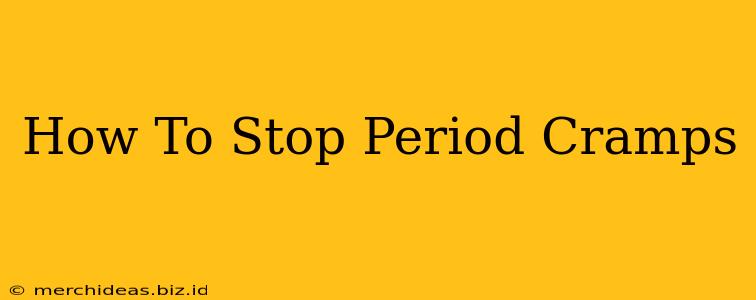Period cramps, or dysmenorrhea, are a common experience for many women, causing debilitating pain and discomfort. Fortunately, there are many ways to manage and even stop period cramps, offering relief and allowing you to live your life to the fullest during your menstrual cycle. This comprehensive guide explores various effective methods, from home remedies to medical interventions.
Understanding Period Cramps
Before diving into solutions, it's crucial to understand why you experience cramps. Period cramps are caused by uterine contractions. These contractions are necessary to shed the uterine lining, but strong contractions can lead to painful spasms. Several factors can influence the intensity of these cramps, including:
- Hormonal imbalances: Fluctuations in estrogen and progesterone levels can trigger stronger contractions.
- Prostaglandins: These hormone-like substances are produced during menstruation and can cause inflammation and pain in the uterus.
- Endometriosis: This condition, where uterine tissue grows outside the uterus, can cause severe cramps.
- Fibroids: Noncancerous growths in the uterus can also contribute to painful periods.
- Pelvic Inflammatory Disease (PID): An infection of the female reproductive organs can cause intense pain.
Natural Ways to Stop Period Cramps
Many effective methods for managing period cramps don't require medication. These natural approaches often target pain relief and relaxation:
1. Heat Therapy:
Applying heat to your abdomen or lower back can relax uterine muscles and ease cramping. Try using:
- Heating pad: A simple and effective solution for gentle, consistent warmth.
- Hot water bottle: A portable and readily available alternative.
- Warm bath or shower: Soaking in warm water can provide overall relaxation and pain relief.
2. Gentle Exercise:
While it might seem counterintuitive, light exercise like yoga, walking, or swimming can improve blood flow and reduce pain. Avoid strenuous activity that might worsen cramps.
3. Massage:
Gently massaging your abdomen can help relax tense muscles and alleviate cramping. Focus on the lower abdomen, applying gentle, circular motions.
4. Dietary Changes:
Certain foods can exacerbate cramps, while others can provide relief. Consider:
- Reducing caffeine and alcohol: These can worsen cramps and dehydration.
- Increasing water intake: Staying hydrated helps reduce inflammation.
- Eating anti-inflammatory foods: Incorporate foods rich in omega-3 fatty acids, like salmon and flaxseed.
5. Relaxation Techniques:
Stress can worsen cramps. Practicing relaxation techniques like deep breathing exercises, meditation, or progressive muscle relaxation can help reduce pain and promote overall well-being.
Medical Interventions for Severe Cramps
If natural methods don't provide sufficient relief, or if your cramps are severe, consult a doctor. They may recommend:
- Over-the-counter pain relievers: Ibuprofen (Advil, Motrin) or naproxen (Aleve) are effective for reducing pain and inflammation.
- Prescription pain medication: For severe cramps, your doctor may prescribe stronger pain relievers.
- Hormonal birth control: Birth control pills, patches, or IUDs can regulate hormone levels and reduce the intensity of cramps.
- Other treatments: Depending on the underlying cause, your doctor may recommend other treatments such as surgery for endometriosis or fibroids.
When to See a Doctor
While period cramps are common, you should consult a doctor if:
- Your cramps are severe and debilitating.
- Your cramps interfere with your daily activities.
- You have a fever or unusual vaginal discharge.
- Your pain worsens over time.
- You suspect an underlying condition such as endometriosis or fibroids.
Taking proactive steps to manage period cramps can significantly improve your quality of life. By understanding the causes of your cramps and exploring the various available options, you can find the best approach to achieve lasting relief and regain control of your well-being.
